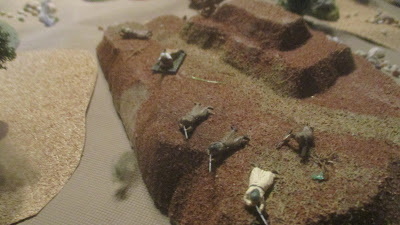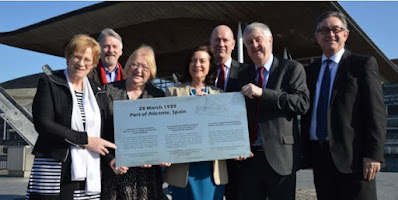Battle for the Peñas de Kaiat
Morocco, 19th
August 1923 by Richard Baber
The first battalion of Regulares was formed on June 30th 1911, under the command of Col. Damaso Berenguer (who later in August 1919 would become High Commissioner to the protectorate) The battalion was made up of native troops under Spanish officers were modelled on similar units created by the French. This unit was titled: Grupo de Fuerzas Regulares Indigenes de Melilla No1, (literally 1st Fusilier Regiment of Natives from Melilla). The battalion consisted of four companies of infantry and a squadron of cavalry scouts. By the next year the strength had increased to six companies of infantry and three squadrons of cavalry.
In early 1923, the Spanish military have withdrawn
from large parts of the protectorate though they tried to hold a solid line of
defence from the sacred city of Tetouan and along the Wad (river) Lau. For the
most part Abd el Krim`s forces are mostly in the Eastern Zone, but there have
been several major (and costly) engagements including Coba Darsa during
June-July. It was along the Wad Lau that Grupo de Regulares d`Tetuán No1 found
itself with four (4) Tabors (battalions) of infantry and one of cavalry. These
units occupied strong-points and blocaos (blockhouses); escorted supply
convoys or carried out patrol activities. Unfortunately the prolonged
inactivity by the Spanish military made Abd el Krim bolder and he attempted to
expand his rebellion into Yebela in the Western Zone by sending harkas (war
bands) to attack Spanish positions, etc. This was part of a two-fold strategy -
attack the Spanish and keep his own warriors busy whilst at the same time
spreading notice of his own power (baraka) into and among the Yebela tribes.
In the months of March and April Abd el Krim, who had the intention of extending his fight to the western zone and winning the support of the Yebela Kabyles, violently attacked M'Ter's post several times - Abd el Krim referred to this position as "the Door of the Western zone" this is quoted in several international newspapers of the time. During the month of May Riffi aggression steps up all along the Wad Lau Valley, causing the Spanish to carry out transfer more troops to the area. The military situation of the Spanish troops continued to be unravel with groups of warriors from local kabyles (previously neutral or even friendly to the Spanish) began to attack speculative targets. Some positions felt themselves more in a state of siege than simply security/police posts.
Meanwhile, in the region of Gomara in June, an attack was being prepared on the city of Xauen and at the end of the month the brother of Abd el Krim leads an attack on the position of Tazza which, in accordance to the tactics usually employed by the guerrillas of the Rif, had been attacked without rest by the harkas day and night. Supply lines to forward positions were cut and the need for a re-supply mission became critical to break the siege but the Minister of State did not authorize its shipment not to upset negotiations with The Raisuni by flooding his area of control with more Spanish troops! The High Commissioner decided nevertheless to send the convoy without prior notification to the Government once again demonstrating a breakdown in communications between the Spanish authorities in Morocco and those of the Madrid government.
In August 1923 negotiations with the Raisuni had reached impasse and the military situation is aggravated by the pressure of the harkas on the more advanced positions of the line Wad Lau - Xauen - Wad Lucus. The general uprising in the Western Zone escalated with the arrival of a large harka led by Ahmed Heriro (one of Abd el Krim`s top field commanders) which increased the number of raids and actually cut communications between Tetouan and Xauen. There were also uprisings in the area of Larache much further west. The whole of the Yebela was now in a state of general rebellion pressing the Spanish forces on all fronts.
In this period of heightened tension and increased
military action, bases and outposts still had to be re-supplied and their
garrisons rotated. 1st Group of Regulares d` Tetuán were assigned to the River
Lau section of the front throughout July and were fully committed to convoy
escort, garrison and outpost duty.
Under the command of Commander Fiscer (officer commanding I Tabor of the Group of Regulars of Tetuán No1)
His
command is composed of:
I Tabor
de Regulares de Tetuán
1º
Squadron of Cavalry of the Group of Regulares of Tetuán
10
charges of the Mobile Ammunition Park
Medium
Section of the Mountain Ambulance
After a couple of days of searching for the enemy with no result, so on 19 August the column was returning to base when it approached the heights known as Peñas de Kaiat, where scouts reported an enemy presence. An attempt by a company from I Tabor to set up an observation post was countered by enemy fire, other Riffi began firing upon engineers constructing a better track near the rocks.
Commander Fiscer with the rest of the Tabor moved forward only to find a large number of the enemy, strongly entrenched; whose intention was to form a strong blocking position and cut the Road between Taguesit and Tazza and intercept communications with Adgos.
Commander
Fiscer gives the order to halt the Taguesit column and for all available forces
to occupy the most dominant point on the high ground and to attack the
enemy. He reinforces the most advanced company with four machine guns to
secure and hold the enemy's centre while the other two companies supported by
four machine guns from 3rd Legion Bandera which was stationed at Adgos,
moved to attack the Flanks.
The battle progressed, with two companies of the Tabor assaulting the crests where the enemy was entrenched, the fighting was intense and the enemy only finally dislodged after vicious hand-to-hand combat! The actions of I Tabor is well supported by the companies of 3rd Bandera and other units of Regulares and the Tercio deployed on the flanks to the east and west.
The enemy consisted of a force of 200 to 250 men, well dug-in and hidden in many of the caves in this rocky outcrop. Thanks to the rapid dispositions made by Commander Fiscer, his command without any artillery preparation and using rapid movement and a decisive, almost reckless assault, surprised and overcame the enemy.
During the fighting, Commander Fiscer kept moving up and down the line, giving and providing clear and accurate orders, this helped his mens morale and contributed to the success of the attack.
Due to the exemplary nature of how they performed during this action, I Tabor was awarded the Collective Military Medal by Royal Order on February 16, 1924.
The I Tabor casualties of this day were four Officers and twenty-six Troops killed and three Officers and thirty-three Troop wounded.
Comandante
Benigno Fiscer Tornero (OC I Tabor, Grupo Regulares de Tetuán)
Capitán
Carlos Muñoz Güi (OC 2nd Company, I Tabor)
Teniente
Fernando Herrero de Tejada y Francia (1st Coy. I Tabor)
Teniente
Manuel Peñarredonda Samaniego (2nd Coy. I Tabor)
Teniente
Celestino Ruiz Sáenz de Santamaría (3rd Coy. I Tabor)
Sargento
Domingo Chao Martín (2nd Coy. I Tabor)
Sargento
Fernando Relimpio Carreño (3rd Coy. I Tabor)
Cabo
Ceferino Santamaría Pérez (1st Coy. I Tabor)
Obviously
this is a fairly straight forward attack/defence over rocky terrain, with the
Spanish forces first trying to clear the high ground then dig in against
possible counter attacks. I decided to cut the table in two with a winding
rough road representing the track between Taguesit and Tazza.
Riffi –
the Berbers must keep the road closed for 20 turns, if they manage this they
gain a strategic victory, if they fail but break or destroy any attacking
Spanish units this should be considered a tactical win.
Spanish – the Spanish forces must clear the Peñas de Kaiat and open the road for the supply column within 20 turns to win, no other result is acceptable.
My table
Now my
first problem is I don`t own enough Regulares to field an entire Tabor on
tabletop, so I was forced to compromise and give 3rd Bandera of La
Legion a bigger role. I decided the Regulares would attack the left side of the Peñas whilst
the legionnaires attacked the right.
My Regulares are a mix of Bandera, Irregular, Barcino
& Tumbling Dice
2 companies each with:
2 x 10 man Pelotónes + HQ
Machine
gun Pelotón
3rd Bandera Spanish Foreign Legion
Now all these except one of two more recent additions were painted by Matt Slade Painting Services at a time when I was getting a few articles published in Miniature Wargames but had no time to paint my own stuff.
My
Legionnaires are a mix of Irregular, Bandera, Barcino and Barcelona Universal
Models
HQ
3 x 10
man Pelotónes (each has an LMG)
Machine
gun Pelotón
Riffi
Harkas
My Riffi are from all over the place - Irregular, Bandera, Italeri, Airfix, Early War Miniatures, Blitz, Force20, Shellhole Scenics
Can be
dug in (medium protection) or hidden from view at the start of the game
4 x 10
warrior Hamsein (all armed with rifles, swords, knives, etc)
Left hill
3 x 10
warrior Hamsein (all armed with rifles, swords, knives, etc)
Reinforcements
on turn 10
1-3 10
man Hamsein
4 LMG
team
5 Juramentados (men sworn to die in
battle) armed only with close combat weapons attack a random Spanish unit and
fight until destroyed
6
10 man Hamsein with inspired leader (adds +1 to all morale/combat rolls to all
with command radius)
The
game
Saw
the Regulares on the left and 3rd Bandera on the right with the
Riffi waiting among the hills
3rd Bandera
Legion pack mule carrying an MMG
moves up towards the next firing position
One Regulares platoon moved straight down the track throughout the game, this brave move effectively outflanked the Berber defence plan on its own!
The rest of the Tabor took to the heights to root out the enemy
On the right the Legionnaires performed splendidly
Finally fighting on the left concluded in an epic and confused melee with the Regulares victorious
A very different game, all infantry with no artillery. Casualties on the Spanish side were far higher than the historical battle – lucky dice!! But they still had the organisation and command to react and counter the Riffi defenders; of course they also had the machine guns which allowed them to lay down suppressing fire from a distance allowing their infantry to get close and clear stubborn enemy positions.







































































